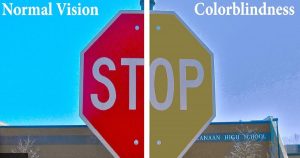
This Is How People With Color Blindness Look At Things
According to various surveys and references, more than 0.5% of women and 8% of men suffer from inaccurate perceptions of colour. Yes! that’s what we call as colour blindness.
This means there is definitely one in your neighbourhood or school class affected by it. Most of them are male because the most common form called red-green colour blindness (a term wich is also misleading) is encoded on the x-chromosome and therefore sex-linked. As red-green colour blindness is inherited from a mother to her son, a father never passes this type of colour blindness on to his children.
The popular subjective website Coloblinder states that there are four main eye deficiencies, they are differentiated according to the paranormally varying image views.
A person with normal vision sees the world around them in these colours.
More than 4.63% of men suffer from it and in many cases don’t even realise, this is the most common blindness observed in men. It’s clear from the photo that the colours have lost some of their brightness, especially with regard to green and red.
Tritanopia is a very rare form of colour blindness affecting men and women to an equally small degree. Those who experience it see the world in greenish pink tones.
As for total colour blindness, it certainly exists, but it’s extremely rare: only 0.00003% of the world’s population has it.
10 Facts About Colour Blindness:
- 99% of all colorblind people are not really colour blind but colour deficient; the term colour blindness is misleading.
- Red-green colour blindness is a combination of red-blindness (proton defects) and green-blindness (deutan defects).
- Color blindness is more prevalent among males than females because the most common form of colour vision deficiency is encoded on the X sex chromosome.
- “What colour is this?” is the most annoying question you can ask your colorblind friend.
- There are three main types of colour vision deficiency: protan, deutan, and tritan defects.
- Strongly colorblind people might only be able to tell about 20 hues apart from each other, with normal colour vision this number rises to more than 100 different hues.
- Colored lenses or glasses can improve colour discrimination in your problem areas but can not give you back normal colour vision.
- Ishihara plates are the best-known colour blindness tests, but they are not the most accurate ones.
- About 8% of all men are suffering from colour blindness.
- The severity of colour blindness is usually divided into the following four categories: slightly, moderate, strong, and absolute.
Few more: